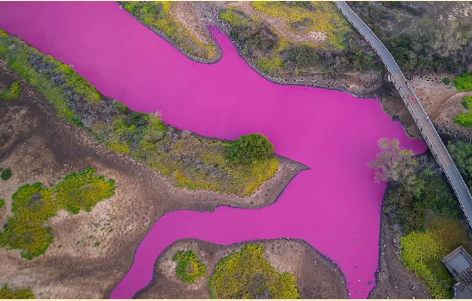 Photo via CNN
Photo via CNN
Kealia Pond is a body of water in Kealia Pond National Wildlife Refuge on the Island of Maui, Hawaii. Since October 30, 2023, the water has taken on a bright magenta color as salt levels rapidly surge. Maui has been in a severe drought for weeks, which is thought to be the cause of such an abnormal salt concentration.
In order to uncover what caused the pink water seemingly out of nowhere, samples of the water were sent to the University of Hawaii. At first, scientists believed that an overproduction of algae was what was causing the water’s pink color. However, lab tests such as DNA analysis were done to reveal that a single-celled organism that lives off of salty water was taking over the pond’s ecosystem. This bacteria, called halobacteria, thrives in extreme conditions, such as the abundance of salt in this water. The tropical temperatures of Maui also boost the bacteria’s growth, as the salt is the only thing the bacteria need for nutrients. Though this bacteria itself isn’t harmful, the higher salt concentrations could become harmful to the organisms that live off of the water.
The lab results revealed that the salt in this water is over 2x the amount of salt in seawater. Though Kealia Pond typically has a higher salinity than other bodies of saltwater, it has never reached this degree before. With salt levels comparable to the Dead Sea, researchers were clueless at first as to why the levels skyrocketed. They then linked it to the excessive lack of rain that the island of Maui has been experiencing. According to the US Drought Monitor, Kealia Pond is experiencing the second-worst drought possible, called an “extreme drought.”
This drought has been getting worse for years, as global warming has been increasing and hitting tropical environments hard. The biggest way climate change contributed to the drought was starting severe wildfires, such as a deadly one that destroyed most of Lahaina, Maui in early August. Wildfires like these destroy the water sources and the ecosystems that rely on them. The islands of Hawaii are isolated, which already makes their water sources very limited. This causes their ecosystems to be even more sensitive to a lack of rain. Additionally, water from the Waikapu Stream typically evens out the salt levels in Kealia Pond by bringing fresh water from the West Maui Mountains. Since that part of Maui is also in a drought, less of that freshwater enters the pond. Due to all of the issues that the drought is causing, salt levels in the pond had the perfect conditions to steadily grow.
Scientists believe that salt levels would only be able to go back to normal if the drought decreases in severity. Once it rains, the Waikapu stream’s freshwater could run down into Kealia Pond to neutralize the salt concentration and the water’s color. Until then, any visitors are warned against going into or drinking the water. Scientists are continually monitoring the water in hopes that something changes. Unfortunately, due to global warming steadily increasing, they don’t have much hope for the drought to end anytime soon. This is the only saltwater pond in Hawaii that has changed colors so far, but the others are also being monitored to ensure it stays that way.
